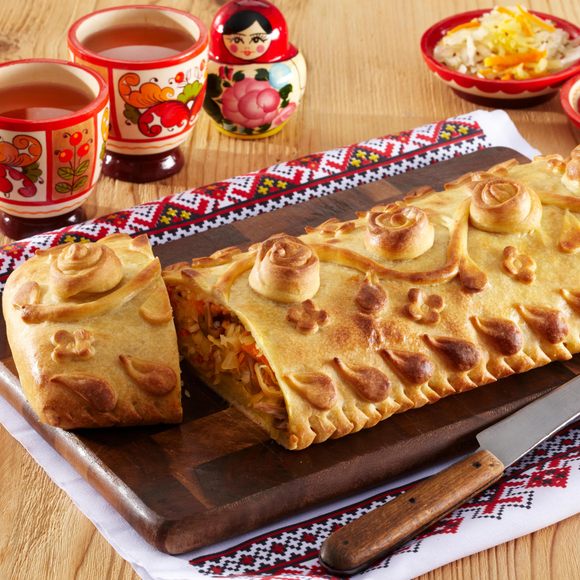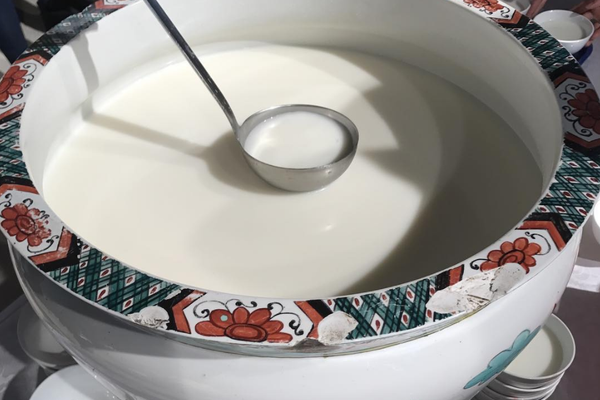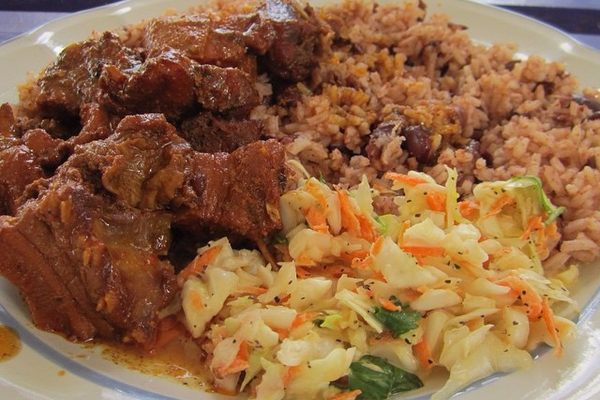When is a pie not a pie? When it is a multi-layered mountain of a meal wrapped inside pastry. The kulebyaka of Russia’s pre-revolution kitchens was just that, made from a recipe so complicated, time-consuming, and expensive that most of the populace had only ever read about it in works by Nikolai Gogol and Anton Chekhov (who referred to it as a “temptation to sin” in a short story).
A kulebyaka is usually a bit taller and longer than a typically pirog (Russian pie) and is made up of a number of layers, each separated by an extremely thin crust and containing a different filling. The intricate pie can be made with a variety of red meats, but it is most commonly filled with fish, such as salmon or sturgeon. In ascending order from driest to sloppiest ingredients (so as to stop the pie falling apart), the pastry might be stuffed with rice, fish, meat (or creamed mushrooms), onions, eggs, and boiled cabbage. The finished product is often decorated with various icons, such as fish, leaves, or flowers.
In the days of “grand” kulebyakas meant for royalty, most versions contained a special ingredient. Vyaziga, made from the dried spinal cord of a sturgeon, imparted a rich, intense flavor. The unique ingredient was famously used in the last meal that first-class passengers aboard the Titanic ever ate. (Perhaps vyaziga is less common in today’s kulebyaka, not just because of the overfishing of sturgeons, but because it is forever linked to the downfall of some of history’s most opulent eaters.)
Today, kulebyaka is a bit more conservative, its recipe simplified during the early years of the Soviet Union. Though it’s no longer the towering monstrosity eaten only by tsars, the updated version is still a hefty addition to any dinner table.
Written By
 JamesRUDD
JamesRUDD
Sources
- www.rbth.com/arts/2015/10/09/kulebyaka_a_recipe_so_complex_it_could_only_exist_in_a_fantasy_49957.html
- theculinarychase.com/2008/08/kulebyaka-russian-fish-pie/
- www.foodreference.com/html/fvesiga.html
- www.rbth.com/russian-kitchen/327083-christmas-kulebyaka-pie
- russiancuisine.us/node/1117
- gherkinstomatoes.com/2010/03/26/17182/
- www.rbth.com/multimedia/video/2014/12/24/delicious_tv_kulebiaka_42537
- books.google.com/books?id=aKEICug2T-EC&pg=PA61&lpg=PA61&dq=The+Kulebyaka+should+be+appetizing,+shameless+in+its+nakedness,+a+temptation+to+sin.&source=bl&ots=nqO15O1eWJ&sig=UZfrOSFiL8pF-kYWYxlgdNcDHEM&hl=en&sa=X&ved=0ahUKEwjC5IP9u5HaAhUMmuAKHcpdCfEQ6AEIMDAB#v=onepage&q=The%20Kulebyaka%20should%20be%20appetizing%2C%20shameless%20in%20its%20nakedness%2C%20a%20temptation%20to%20sin.&f=false
- www.nytimes.com/1998/04/26/nyregion/culinary-tribute-to-the-titanic.html
- www.newyorker.com/magazine/2013/07/29/cooking-with-daniel













